Drought-induced microbial dynamics in cowpea rhizosphere: Exploring bacterial diversity and bioinoculant prospects
- PMID: 40132013
- PMCID: PMC11936235
- DOI: 10.1371/journal.pone.0320197
Drought-induced microbial dynamics in cowpea rhizosphere: Exploring bacterial diversity and bioinoculant prospects
Abstract
Rhizospheric bacterial communities in plants contribute to drought resilience by promoting plant-soil interactions, yet their biodiversity and ecological impacts are not fully characterized. In cowpeas, these interactions may be crucial in enhancing tolerance to drought conditions. In this study, cowpea plants were subjected to drought treatment, the soil attached to the roots was collected, environmental DNA (e-DNA) was extracted, and the bacterial communities were identified as amplicon sequence variants (ASVs) by metagenomics analysis of the 16S rRNA gene. Microbial communities under drought and control conditions were analyzed using taxonomy and diversity metrics. The sequencing results revealed 5,571 ASVs, and taxonomic analysis identified 1,752 bacterial species. Alpha and beta diversity analyses showed less conserved microbial community structures and compositions among the samples isolated from the rhizosphere under drought conditions compared to untreated samples, implying the enhancement effect of drought on species' biodiversity and richness. The differential accumulation analysis of the bacterial community identified 75 species that accumulated significantly (P ≤ 0.05) in response to drought, including 13 species exclusively present, seven absent, and 46 forming a high-abundance cluster within the hierarchical heatmap. These species were also grouped into specific clades in the phylogenetic tree, suggesting common genetic ancestry and potentially shared traits associated with drought tolerance. The differentially accumulated bacterial list included previously characterized species from drought and saline habitats. These findings suggest that drought stress significantly alters the composition and abundance of epiphytic bacterial communities, potentially impacting the rhizosphere's ecological balance and interactions with cowpeas. The results highlight microbial adaptations that enhance plant resilience through improved stress mitigation, providing meaningful understandings for advancing sustainable agriculture and developing microbial-based strategies to boost crop productivity in drought-prone regions.
Copyright: © 2025 Halo et al. This is an open access article distributed under the terms of the Creative Commons Attribution License, which permits unrestricted use, distribution, and reproduction in any medium, provided the original author and source are credited.
Conflict of interest statement
The authors have declared that no competing interests exist.
Figures
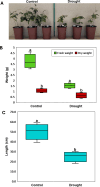
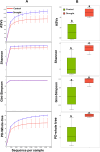

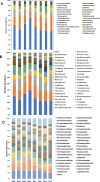
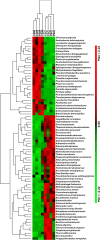
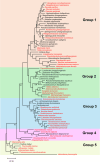
Similar articles
-
Rhizobacterial Community Structure Differs Between Landrace and Cultivar of Rice Under Drought Conditions.Curr Microbiol. 2024 Aug 30;81(10):334. doi: 10.1007/s00284-024-03860-0. Curr Microbiol. 2024. PMID: 39214888
-
Uncovering the dominant role of root metabolism in shaping rhizosphere metabolome under drought in tropical rainforest plants.Sci Total Environ. 2023 Nov 15;899:165689. doi: 10.1016/j.scitotenv.2023.165689. Epub 2023 Jul 20. Sci Total Environ. 2023. PMID: 37481084
-
Structure and dynamics of microbial communities associated with the resurrection plant Boea hygrometrica in response to drought stress.Planta. 2024 Jun 10;260(1):24. doi: 10.1007/s00425-024-04459-2. Planta. 2024. PMID: 38858226
-
Hub metabolites at the root-microbiome interface: unlocking plant drought resilience.Trends Plant Sci. 2025 May 19:S1360-1385(25)00106-2. doi: 10.1016/j.tplants.2025.04.007. Online ahead of print. Trends Plant Sci. 2025. PMID: 40393817 Review.
-
Species divergence and the measurement of microbial diversity.FEMS Microbiol Rev. 2008 Jul;32(4):557-78. doi: 10.1111/j.1574-6976.2008.00111.x. Epub 2008 Apr 22. FEMS Microbiol Rev. 2008. PMID: 18435746 Free PMC article. Review.
Cited by
-
Diversified Soil Types Differentially Regulated the Peanut (Arachis hydropoaea L.) Growth and Rhizosphere Bacterial Community Structure.Plants (Basel). 2025 Apr 9;14(8):1169. doi: 10.3390/plants14081169. Plants (Basel). 2025. PMID: 40284057 Free PMC article.
References
-
- Zipper SC, Qiu J, Kucharik CJ. Drought effects on US maize and soybean production: spatiotemporal patterns and historical changes. Environ Res Lett. 2016;11(9):094021. doi: 10.1088/1748-9326/11/9/094021 - DOI
-
- Roy R, Kundu S, Kumar R. The impacts and evidence of Australian droughts on agricultural crops and drought related policy issues-a review article. 2021.
-
- Mansour S. Geospatial modelling of drought patterns in Oman: GIS-based and machine learning approach. Model Earth Systems Environ. n.d.;1(1):1–21.
MeSH terms
Substances
LinkOut - more resources
Full Text Sources

